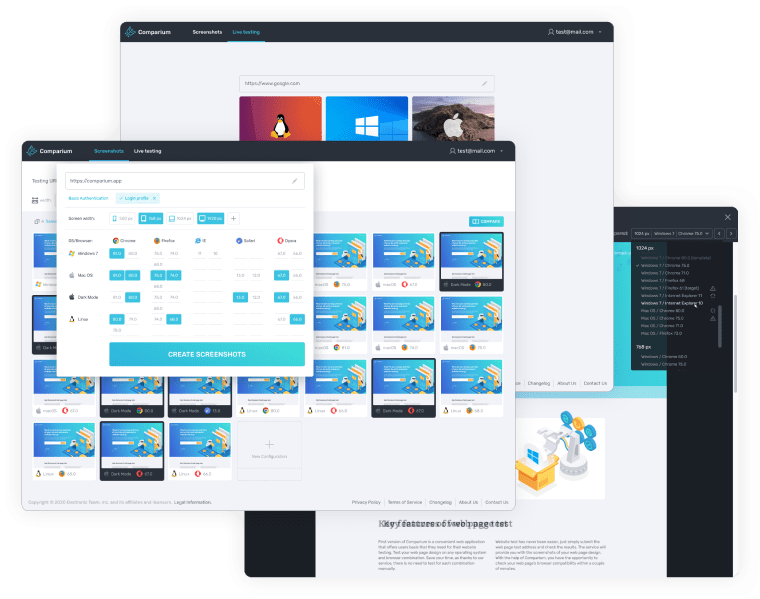Table of contents
- Testing Functionality
- Testing Usability
- Testing the Interface
- Testing Compatibility
- Testing Performance
- Testing Security
- FAQ
Testing Functionality

The most important part of a website testing checklist is the one targeting functionality. Sure, design and display are also important. However, making sure every link, form, and database works properly, without errors, is vital. To get to that point, you need to add functional requirements such as:
- Clicking on buttons and links to check if the proper page opens
- Checking that no link takes to an empty page
- Making sure that the 404 page is active in case some pages are removed or no longer available
Testing Forms
Any website testing checklist should also include in-depth forms testing. The main things to take into consideration when dealing with forms are:
- Double-checking that no invalid input is accepted
- Going over mandatory and optional fields to ensure proper functionality
- Character length and limits
- Radio buttons testing
- Setting the default values on page load/reload
- Forms formatting to ensure proper readability
Any functionality testing checklist should also include a thorough overview of cookies. You should test the following situations at least:
- How the application reacts when a user deletes cookies while navigating the site
- What happens if cookies are deleted after a site visit
Last but not least, all test cases for web applications should address HTML and CSS to guarantee that search engines can easily crawl. These checks should include:
- Spotting syntax errors
- Checking colors schemes fit the standard and are readable
Testing Usability

No matter if we’re talking about test cases for web application in manual testing or automated processes, usability is the next important thing to check. It can be done on targeted audiences or general users and it confirms that the site offers a friendly interface, any instructions provided are clear, and navigation is intuitive. The usability testing also includes going over the content to identify spelling or grammatical errors, as well as checking fonts and colors. Here’s an example of a usability web testing checklist:
- Check website content and general navigation
- Links, buttons, and menus to other pages should be easily accessible and consistent in all instances
- All content needs to be readable, free of spelling or grammatical errors
- All images on the site should have "alt text" description
- Does the web app offer a clear idea of its target audience?
- Does the application deliver a recognizable and consistent interface and interaction?
More Scenarios
An application testing checklist that focuses on usability can also include other scenarios such as:
- Font and style consistency throughout the app
- Text alignment on all pages
- Standardization of format and size for buttons and fields in the web application
- Graying-out fields that are no required or disabled
- The presence of the title on all pages
- Radio buttons, dropdowns, text boxes, and other fields should also be accessible from the keyboard
- Checking all the above in various screen resolutions on the same internet browser
Testing the Interface

Next in line for a proper web application testing checklist is the interface. Starting with the server-side interface, testing the communication and compatibility between server, software, hardware, database, and network is also essential.
Focus on the following
- Application server and Web server interface
- Database and application server interface
If you’re wondering how to write test cases for web application with an example of proven efficiency in interface checking, we have the answer for you. Always start by double-checking the interactions between how app server and web server/database server and app server are handled. If during any interrogation, either the database or web server delivers an error message, this message should be properly displayed to the users through the application server.
After all server communication is checked for functionality, it’s time to move on to the visual part of the testing process - Compatibility.
Testing Compatibility

Even though it’s further down the list in our test cases example for web application checking, compatibility is also essential for the entire app to work properly. It ensures that no matter what browser or operating system users have on their devices, the web app looks and functions properly. It contains several steps:
- Compatibility across multiple browsers
- Compatibility over various Operating Systems
- Mobile browsing compatibility
Browser Compatibility
Putting together a website test script that deals with browser compatibility isn’t the simplest of procedures. This section can be the most influential part of the entire testing process. Since some apps are overly dependent on browsers, different configurations may return inconsistent results.
First of all, make sure that the coding is done in a cross-browser-compatible platform. If you include AJAX or Java scripts for UI or security checks, you should especially focus on browser compatibility. These are the elements that usually don’t do very well when crossing from one browser to another since each internet browser has a slightly different approach, especially older ones. Considering all these, the best answer to "How to test web application for browser compatibility?" is "Covering all grounds". Include browsers such as Internet Explorer, AOL, Safari, Chrome, Netscape, Firefox, or Opera in your tests. If you’re not sure where to start, tools like Comparium give you all the help you need. With it, you will find your way through testing web applications for compatibility with browsers and operating systems.
OS Compatibility
Similar to browser compatibility, some functionality aspects may be influenced by the operating system. So,even if you manage to get your web app to function the same across browsers, you mustn’t leave out the operating systems. APIs may change and most operating systems use different calls for interface and graphic designs.
Therefore, make sure to include the Windows, Mac, Unix, Linux, and Solaris operating systems since these are the most popular at the moment.
Mobile Browsing Tests
It’s no secret that more and more users browse the internet from a smartphone and tablet. Desktop and laptop use constantly decreased during recent years and that’s why mobile testing is mandatory. Include various mobile browsers and screen resolutions in your testing checklist to make sure you offer them a smooth experience. Most cross-browser testing tools also include mobile versions nowadays.
Testing Performance

When talking about performance in web application testing, we refer to loading times, stress testing, and other features that refer to how your app interacts with various browsers and operating systems from this point of view. It’s best to create several sample test cases for web application performance testing, using different internet speeds.
Load testing is basically testing what happens when multiple users access the same page. Ideally, your web applications will have no issue handling several requests at the same time. The conversation is much wider than just how your app reacts to multiple visits as you have to factor in the hosting service and many other elements. However, making sure everything is working properly on your end is going to make troubleshooting a lot smoother.
Just like with browser compatibility, stress testing should be done on various operating systems, screen resolutions, and browser versions. Testing performance will also give you a clear idea of how scalable your website is. It’s usually a balancing act between load balancing, response time between user requests and server reply, and the load a web app can sustain before crashing.
Testing Security

Finally, we’re taking a look at the process of security testing before going live with the website application. Cybersecurity is vital for any business that wants to have a good reputation in this day and age. Protecting your data, and most importantly users’ data, is crucial. Testing for security will also increase tractions and will allow you to sleep better at night knowing the risk of breaches is very low. A bulletproof security website checklist should include all of the following:
- Checking that every piece of important data like financial information, passwords, and answers to security questions are submitted via HTTPS and come with an SSL encryption
- Check that the financial information and passwords are displayed via an encrypted format
- Double-check that all pages that accept data from users run SQL Injection to access the database
- Verify error messages to make sure they don’t display other internal data
- Test to see what happens when the session expires or the user logs out - there should be no possibility to continue without logging in again
- Your application security testing checklist should also contain checking if unsecured and secured pages can be accessed without login - depending on how you set up the functionality for this feature. You should run this check on multiple browsers as well
- Make sure the "View Source Code" isn’t enabled for all users
- Cookies should always be stored in encrypted form
Final Thoughts
We’ve been through the most important aspects of putting together a solid website testing checklist to make sure everything is alright before going live with your website or application. As mentioned in the introduction, there’s a lot of ground to cover. With all the new browsers and operating systems developed nowadays, things are constantly evolving and you need to adapt. Applying these elements to your checklist ensures a thorough checking and gives you great chances for going live with an issue-free site. Don’t forget to use all the tools that were also developed to help ease the entire process. Cross-browser testing tools, code checkers, content crawlers, and many other apps will make testing more efficient and accurate.
FAQ
- Start with a solid title
- Add a solid description as well
- Preconditions and assumptions need to be added a swell
- All the steps should be concise and clear, without room for assumption
- Predict the expected test result
- Make the test case flexible enough to reuse it
Description suggestion: A user with a registered account should be able to easily log in on gmail.com.


